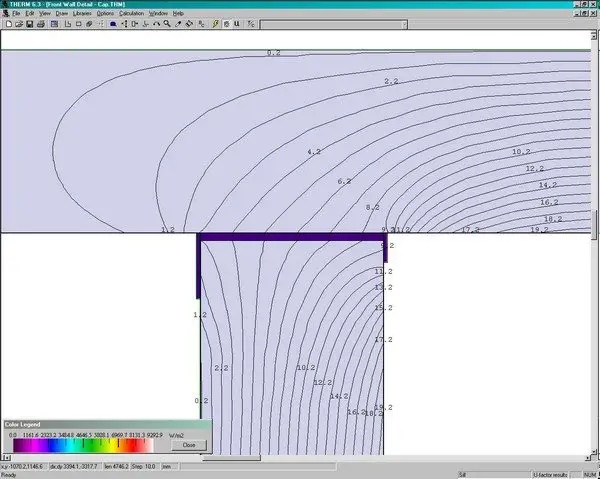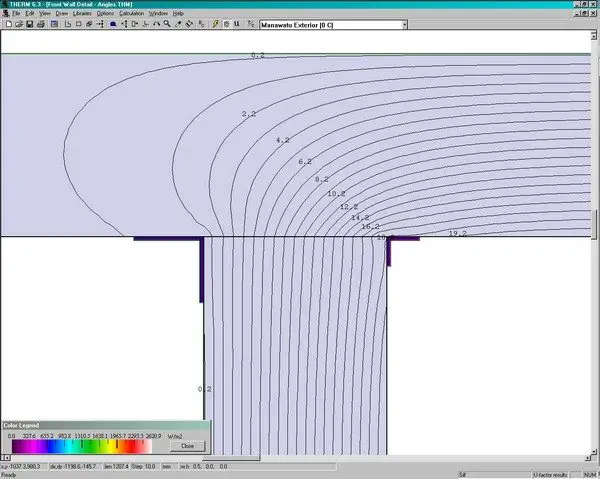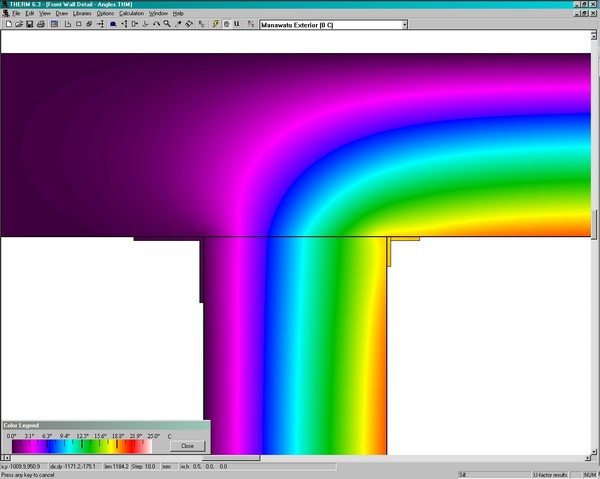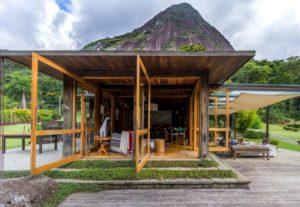This is structural design at the roof to wall junction required to resist the large uplift forces created by the moderately high winds in the area (80 to 90 km/hour is not uncommon). The image is simplified as it doesn’t show the angle of the skillion roof. Indoors is the white space at the bottom right, and outdoors is the bottom left and top.

The first iteration of the design used a 10 mm thick structural steel strip across the top of the wall to secure the roof to the wall. This image shows the isotherms (lines connecting places of equal temperature) when it’s 22°C indoors and 0°C outdoors (typical winter temperatures here). It’s a bit difficult to see, but the indoor temperature at the roof to wall junction goes down to 9.2°C, and the outdoor temperature at the junction is 3.2°C.

This shows the same information in a false colour temperature representation You can clearly see how the indoor junction is being pulled well down below room temperature and how the heat flow ‘bulges’ toward the outdoor junction.
Big deal. Nice pictures, but what does it mean? There are two real world problems with this outcome The first is that it’s cold enough around the indoor junction to form a strip of condensation indoors all along the front wall of the house. The second is that the heat being lost here has a direct impact on how much heat is needed to maintain the indoor temperature.
If we do some very simple thermal loss calculations; at 22°C indoors and 0°C outdoors the heat loss through the steel plate is 1.1 kW, which is additional energy needed to be added to maintain the target indoor temperature.
The final design used a different arrangement with the structural strength coming from two steel angles either side of the wall to secure the roof. The 0.56 mm thick steel of the skillion roof is retained without any thermal break for structural integrity purposes, but it carries only a 50 W energy cost.

The indoor temperature at the roof to wall junction now goes down to only 19.2°C (a 10°C difference compared to the first design), and the outdoor temperature at the junction is 0.2°C (almost no difference compared to the outdoor temperature).

And the same picture with false colour temperature representation. Sigh … isn’t it gorgeous?
Insulation
Let’s go back to the pea on the plate. Remember that for the same amount of tipping of the plate that the pea rolled faster when there was no gravy on the plate? Let’s push that analogue as far as it will go – super glue the pea to the plate. Tip the plate. Nothing – the pea stays exactly where it is and no heat is flowing. We’re now simulating a perfect insulator; something that does not conduct any heat at all. In the real world, we don’t have materials like that, so the ideal analogue would be a pea creeping sloooowly across the plate. Treacle or molasses anyone?
High levels of thermal insulation reduce the heat that flows through the building envelope, in turn reducing to a minimum the amount of energy needed to keep the interior warm or cool. The most important considerations for thermal insulation are how well it resists the flow of heat and how thick it is. Even the best insulators don’t do much if used in thin layers. So why is thickness important?
Time for a science experiment
Paper is only a slightly worse insulator than rock wool insulation (http://www.engineeringtoolbox.com/thermal-conductivity-d_429.html). Take a sheet of paper (newspaper works well) and place it on a cold surface that doesn’t warm quickly (the steel side of a fridge is good). Now press your palm tightly against the paper – your palm will quickly feel the cold coming through. Now pile about 20 sheets of paper on top of each other and do the same. Your palm will initially feel cold, but over a period of a minute or so will warm up. That’s the insulation value of paper coming into play.
It’s exactly the same with a building. The thicker the insulation, the better it performs. The ideal thickness of insulation is a balance between cost of the insulations vs. the cost of the energy that would be needed to maintain comfort levels. The bigger the difference between the indoor and outdoor temperatures (irrespective of whether it’s hot or cold outdoors), the more cost effective it is to add insulation.
But the best insulation in the world is a waste if the building loses energy through thermal bridges and air leaks.
O.K! We both made it this far. Congratulations again. You’re well on the way to understanding why so many home owners are becoming advocates of the Passivehaus system.
Part 3 will, I promise, raise the odd eye-brow as I introduce the concepts of ventilations and air tightness. Yes, they seem to be mutually exclusive but, in fact, work together to create an excellent living environment in all climates.
Once again, please share your thoughts and your questions are, as always, welcome. Just scroll down to the ‘Comments’ section below.
Thanks for joining me. ‘See’ you shortly.
Leonard Smit
Interested in retro-fitting your existing home to make it super-insulated? This book will guide you…






